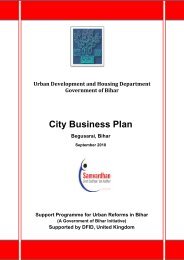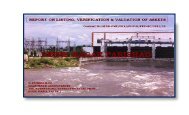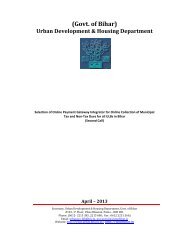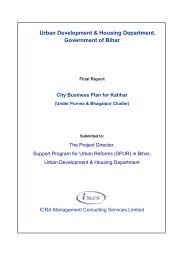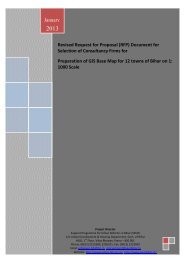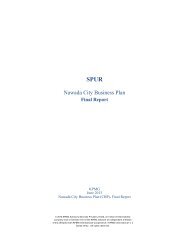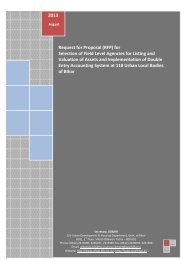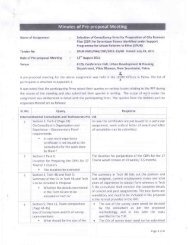CITY BUSINESS PLAN
CITY BUSINESS PLAN
CITY BUSINESS PLAN
You also want an ePaper? Increase the reach of your titles
YUMPU automatically turns print PDFs into web optimized ePapers that Google loves.
3 ECONOMIC DEVELOPMENT<br />
3.1 Urban Economy with Regional Potential<br />
Muzaffarpur district largely has an agrarian economy. Considering the district as the hinterland for a<br />
significant portion of the industrial and commercial activities in the city region, on the basis of year<br />
2005‐06 data5, the district produces 3.0% rice, 3.5% wheat, and 5.9% vegetables of Bihar state‟s total<br />
production. The district is famous for fruits e.g. litchi and mango, which are exported to other parts of<br />
the country and even abroad. Apart from good concentration of cattle, fisheries, poultry and livestock,<br />
the district also has potential for dairy products, cattle feeding plants, honey related products, abattoir,<br />
raw hide mandi, leather industries and meat processing. Along with these the district is also rich in<br />
handicraft works especially lac bangles, sujni embroidery and appliqué work (CDP Muzaffarpur).<br />
3.2 Work Force Participation Rate<br />
As per 2001 Census, Muzaffarpur Municipal Corporation has 25% Work Force Participation Rate<br />
(WFPR) which is low when compared to National, State and District averages. The male worker<br />
population is 68,206 which is 22.3% of the total population of the city, but it comprises 89% of the<br />
total workers in Muzaffarpur city. However, only 11% female workers form part of the total work<br />
force which is hardly 2.7% of the total population of the city. As far as engagement of workers in<br />
different economic activities are concerned, the highest proportion of workforce is engaged in other<br />
activities (94%), followed by HH industries (4%), cultivation (1%) and Agriculture Labour (1%).<br />
A summary tabulation of economic activity-mix in the city is tabulated in Table 3.7 below:<br />
Table 3.1: Comparative Urban Work Force Participation Rate<br />
Particulars Total Workers Male Workers Female Workers WFPR<br />
Urban India 92,278,654 76,175,323 16,103,331 32%<br />
Bihar 2,222,037 1938181 283,856 26%<br />
Muzaffarpur District 89,016 78676 10,340 26%<br />
MMC 76,518 68206 8,312 25%<br />
Source: Census of India, 2001<br />
Table 3.2: Work Force Participation Rate of Muzaffarpur City<br />
Workers<br />
Percentage<br />
Cultivators 1<br />
Agriculture Laborer 1<br />
HH Industries 4<br />
5 According to the resource mapping undertaken by Gherzi‐Genesis.<br />
Final Report<br />
3-1




